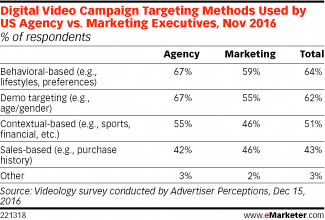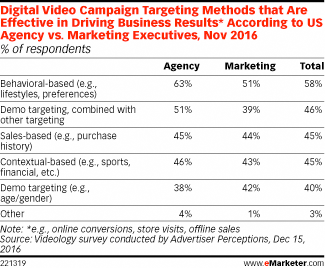Taking Video Ad Targeting Beyond Demographics
January 4, 2017
![]() Demographic targeting (using consumers’ age and gender to make media decisions) continues to be used widely, but advertisers are raising questions about its effectiveness.
Demographic targeting (using consumers’ age and gender to make media decisions) continues to be used widely, but advertisers are raising questions about its effectiveness.
 A November 2016 survey by Videology found that 62% of executives said they used “demo targeting.” It was the second-most commonly cited targeting technique, falling just two percentage points below behavioral targeting. Contextual and sales-based targeting came in considerably lower in the survey.
A November 2016 survey by Videology found that 62% of executives said they used “demo targeting.” It was the second-most commonly cited targeting technique, falling just two percentage points below behavioral targeting. Contextual and sales-based targeting came in considerably lower in the survey.
However, when asked about the most effective targeting methods for digital video, demo-based targeting was rated among the least effective. Only 40% of respondents from the agency and marketing worlds said the method was effective, coming in fourth out of the five methods studied.
 In some ways, the survey suggests lack of enthusiasm for targeting in general. Only one form of targeting—behavioral—was called effective by a majority of respondents. The executives in the survey didn’t even express much confidence in using demographic targeting in concert with other forms of targeting: Just 46% said a combination approach was effective.
In some ways, the survey suggests lack of enthusiasm for targeting in general. Only one form of targeting—behavioral—was called effective by a majority of respondents. The executives in the survey didn’t even express much confidence in using demographic targeting in concert with other forms of targeting: Just 46% said a combination approach was effective.
Videology is not the first to notice some dissatisfaction with demographic-based targeting. An earlier study of digital video ads by TubeMogul, which examined whether or not such ads were “on-target” for their designated age and gender, found that less than half of digital video ads during the period studied reached their intended consumer groups in the 35-54 age group. Less than half of digital video ads in TubeMogul’s study were also on-target for their target gender.
Courtesy of eMarketer






























